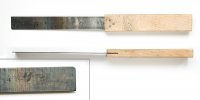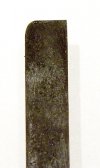Dimner
Named Man
What do you guys use for pot scraping, especially for bottom pour pots?
I have been going back to my bottom pour pot recently and after the 3rd round of a totally filled pot, I had some very bad concentrated buildup in the lower 2 inches of the pot. And in the spout cone was a bunch of crud that was causing inclusions on nearly ever pour. A vast majority of this was the typical mustard yellowish buildup one finds in a casting pot. Not sure if that helps.
When I flux, I stir and scrape like mad with my spoon, but it seems that it's not getting any of the gunk off the wall on the lowest 2 inches, and is not reaching in between the spout stem and the wall of the pot. It's an RCBS pro melt 2. I did some searching for tips, and saw an old hacksaw blade helps, but I'm not seeing how much it will help other than getting in between the stem and the wall. Do you modify the blade at all?
Last night I spent about an hour and half draining all the lead and cleaning the walls back to the stainless steel. And working on getting all that gunk out of the spout.
So what tool do you use to scrape your walls on a half or nearly full pot as well as scrape that little concave radius intersection of the wall and the bottom of the pot?
I have been going back to my bottom pour pot recently and after the 3rd round of a totally filled pot, I had some very bad concentrated buildup in the lower 2 inches of the pot. And in the spout cone was a bunch of crud that was causing inclusions on nearly ever pour. A vast majority of this was the typical mustard yellowish buildup one finds in a casting pot. Not sure if that helps.
When I flux, I stir and scrape like mad with my spoon, but it seems that it's not getting any of the gunk off the wall on the lowest 2 inches, and is not reaching in between the spout stem and the wall of the pot. It's an RCBS pro melt 2. I did some searching for tips, and saw an old hacksaw blade helps, but I'm not seeing how much it will help other than getting in between the stem and the wall. Do you modify the blade at all?
Last night I spent about an hour and half draining all the lead and cleaning the walls back to the stainless steel. And working on getting all that gunk out of the spout.
So what tool do you use to scrape your walls on a half or nearly full pot as well as scrape that little concave radius intersection of the wall and the bottom of the pot?


